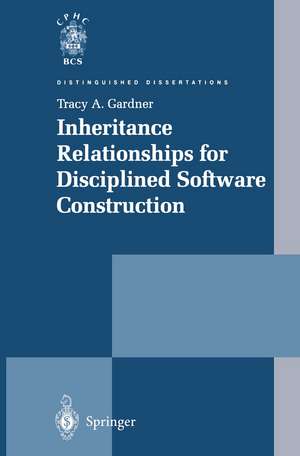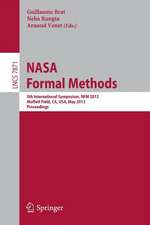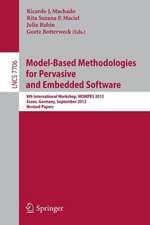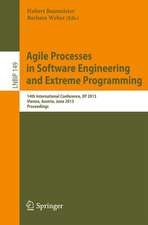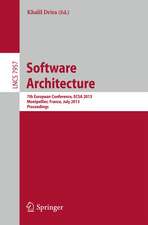Inheritance Relationships for Disciplined Software Construction: Distinguished Dissertations
Autor Tracy A. Gardneren Limba Engleză Paperback – 29 oct 2012
This book introduces a model of inheritance based around five fundamental inheritance relationships. Each relationship has a clear conceptual basis, representing a fundamental, specialised use of inheritance. The resulting model replaces a confused notion of inheritance with five distinct conceptual relationships supporting more precise modelling of systems and capturing the semantic intent of each use of inheritance within a system.
| Toate formatele și edițiile | Preț | Express |
|---|---|---|
| Paperback (1) | 328.60 lei 6-8 săpt. | |
| SPRINGER LONDON – 29 oct 2012 | 328.60 lei 6-8 săpt. | |
| Hardback (1) | 579.81 lei 6-8 săpt. | |
| Springer – 31 aug 2002 | 579.81 lei 6-8 săpt. |
Din seria Distinguished Dissertations
- 20%
 Preț: 290.51 lei
Preț: 290.51 lei - 15%
 Preț: 633.68 lei
Preț: 633.68 lei - 15%
 Preț: 645.47 lei
Preț: 645.47 lei - 20%
 Preț: 654.05 lei
Preț: 654.05 lei - 20%
 Preț: 647.79 lei
Preț: 647.79 lei - 20%
 Preț: 994.92 lei
Preț: 994.92 lei - 20%
 Preț: 648.26 lei
Preț: 648.26 lei - 20%
 Preț: 641.34 lei
Preț: 641.34 lei - 20%
 Preț: 328.09 lei
Preț: 328.09 lei - 20%
 Preț: 325.30 lei
Preț: 325.30 lei - 20%
 Preț: 926.94 lei
Preț: 926.94 lei - 20%
 Preț: 639.52 lei
Preț: 639.52 lei - 20%
 Preț: 640.69 lei
Preț: 640.69 lei - 20%
 Preț: 603.36 lei
Preț: 603.36 lei - 20%
 Preț: 637.56 lei
Preț: 637.56 lei - 20%
 Preț: 643.30 lei
Preț: 643.30 lei - 20%
 Preț: 640.51 lei
Preț: 640.51 lei - 20%
 Preț: 640.19 lei
Preț: 640.19 lei - 20%
 Preț: 325.63 lei
Preț: 325.63 lei
Preț: 328.60 lei
Preț vechi: 410.75 lei
-20% Nou
Puncte Express: 493
Preț estimativ în valută:
62.89€ • 65.15$ • 52.48£
62.89€ • 65.15$ • 52.48£
Carte tipărită la comandă
Livrare economică 22 martie-05 aprilie
Preluare comenzi: 021 569.72.76
Specificații
ISBN-13: 9781447110927
ISBN-10: 1447110927
Pagini: 220
Ilustrații: XII, 204 p.
Dimensiuni: 155 x 235 x 12 mm
Greutate: 0.31 kg
Ediția:Softcover reprint of the original 1st ed. 2002
Editura: SPRINGER LONDON
Colecția Springer
Seria Distinguished Dissertations
Locul publicării:London, United Kingdom
ISBN-10: 1447110927
Pagini: 220
Ilustrații: XII, 204 p.
Dimensiuni: 155 x 235 x 12 mm
Greutate: 0.31 kg
Ediția:Softcover reprint of the original 1st ed. 2002
Editura: SPRINGER LONDON
Colecția Springer
Seria Distinguished Dissertations
Locul publicării:London, United Kingdom
Public țintă
Professional/practitionerCuprins
1 Introduction.- 1.1 Objectives and limitations.- 1.2 Approach.- 1.3 Conventions.- 1.4 Outline.- 2 Current Understanding of Inheritance.- 2.1 The origin of inheritance.- 2.2 What is inheritance?.- 2.3 Advantages of inheritance.- 2.4 Problems with inheritance.- 2.5 Understanding inheritance.- 2.6 Conclusion.- 3 Structured Inheritance Relationships (SIRs).- 3.1 Context and scope.- 3.2 Variant.- 3.3 View.- 3.4 Evolution.- 3.5 Construction.- 3.6 Specialisation.- 3.7 Conclusion.- 4 A new model of inheritance.- 4.1 Underlying model.- 4.2 Presentation of the SIR model.- 4.3 SIR.- 4.4 SIR Specialisation.- 4.5 SIR Variant.- 4.6 SIR Construction.- 4.7 SIR View.- 4.8 SIR Evolution.- 4.9 Multiple inheritance in the SIR model.- 4.10 Relationship with other work.- 4.11 Conclusions.- 5 Techniques for Structured Use of Inheritance.- 5.1 Required architectural qualities.- 5.2 Planning techniques.- 5.3 Variability techniques.- 5.4 Adaptation techniques.- 5.5 Modification techniques.- 5.6 Conclusion.- 6 Case Studies: Applying The Sir Framework.- 6.1 Restricted subclasses: the square/rectangle problem.- 6.2 Binary Methods: Points and Coloured Points.- 6.3 Case study: web site manager.- 6.4 Conclusion.- 7 Implementation techniques.- 7.1 Levels of support.- 7.2 Implementation approaches.- 7.3 Support for specialisation.- 7.4 Support for variant.- 7.5 Support for construction.- 7.6 Support for view.- 7.7 Support for evolution.- 7.8 CASE tool lSupport.- 7.9 Conclusion.- 8 Conclusion.- 8.1 Structured inheritance relationships.- 8.2 A new model of inheritance.- 8.3 Techniques for disciplined software construction.- 8.4 Inheritance for reuse.- 8.5 Understanding of inheritance.- 8.6 Directions for new research.- 8.7 A final word.- A Glossary of terms.- References.
